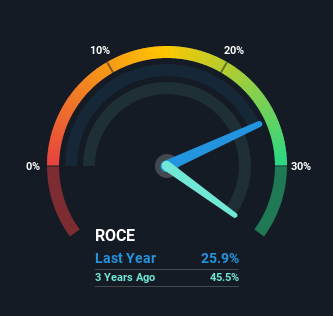Returns On Capital Signal Tricky Times Ahead For Gulf Oil Lubricants India (NSE:GULFOILLUB)

There are a few key trends to look for if we want to identify the next multi-bagger. In a perfect world, we'd like to see a company investing more capital into its business and ideally the returns earned from that capital are also increasing. Basically this means that a company has profitable initiatives that it can continue to reinvest in, which is a trait of a compounding machine. Having said that, while the ROCE is currently high for Gulf Oil Lubricants India (NSE:GULFOILLUB), we aren't jumping out of our chairs because returns are decreasing.
Return On Capital Employed (ROCE): What is it?
If you haven't worked with ROCE before, it measures the 'return' (pre-tax profit) a company generates from capital employed in its business. The formula for this calculation on Gulf Oil Lubricants India is:
Return on Capital Employed = Earnings Before Interest and Tax (EBIT) ÷ (Total Assets - Current Liabilities)
0.26 = ₹2.5b ÷ (₹16b - ₹6.5b) (Based on the trailing twelve months to September 2021).
Thus, Gulf Oil Lubricants India has an ROCE of 26%. That's a fantastic return and not only that, it outpaces the average of 17% earned by companies in a similar industry.
Check out our latest analysis for Gulf Oil Lubricants India

Historical performance is a great place to start when researching a stock so above you can see the gauge for Gulf Oil Lubricants India's ROCE against it's prior returns. If you want to delve into the historical earnings, revenue and cash flow of Gulf Oil Lubricants India, check out these free graphs here.
How Are Returns Trending?
On the surface, the trend of ROCE at Gulf Oil Lubricants India doesn't inspire confidence. To be more specific, while the ROCE is still high, it's fallen from 54% where it was five years ago. Although, given both revenue and the amount of assets employed in the business have increased, it could suggest the company is investing in growth, and the extra capital has led to a short-term reduction in ROCE. And if the increased capital generates additional returns, the business, and thus shareholders, will benefit in the long run.
On a side note, Gulf Oil Lubricants India has done well to pay down its current liabilities to 41% of total assets. That could partly explain why the ROCE has dropped. What's more, this can reduce some aspects of risk to the business because now the company's suppliers or short-term creditors are funding less of its operations. Some would claim this reduces the business' efficiency at generating ROCE since it is now funding more of the operations with its own money. Keep in mind 41% is still pretty high, so those risks are still somewhat prevalent.
The Bottom Line On Gulf Oil Lubricants India's ROCE
Even though returns on capital have fallen in the short term, we find it promising that revenue and capital employed have both increased for Gulf Oil Lubricants India. However, despite the promising trends, the stock has fallen 22% over the last five years, so there might be an opportunity here for astute investors. As a result, we'd recommend researching this stock further to uncover what other fundamentals of the business can show us.
If you want to know some of the risks facing Gulf Oil Lubricants India we've found 2 warning signs (1 is significant!) that you should be aware of before investing here.
If you'd like to see other companies earning high returns, check out our free list of companies earning high returns with solid balance sheets here.
New: Manage All Your Stock Portfolios in One Place
We've created the ultimate portfolio companion for stock investors, and it's free.
• Connect an unlimited number of Portfolios and see your total in one currency
• Be alerted to new Warning Signs or Risks via email or mobile
• Track the Fair Value of your stocks
Have feedback on this article? Concerned about the content? Get in touch with us directly. Alternatively, email editorial-team (at) simplywallst.com.
This article by Simply Wall St is general in nature. We provide commentary based on historical data and analyst forecasts only using an unbiased methodology and our articles are not intended to be financial advice. It does not constitute a recommendation to buy or sell any stock, and does not take account of your objectives, or your financial situation. We aim to bring you long-term focused analysis driven by fundamental data. Note that our analysis may not factor in the latest price-sensitive company announcements or qualitative material. Simply Wall St has no position in any stocks mentioned.
About NSEI:GULFOILLUB
Gulf Oil Lubricants India
Manufactures, markets, and trades lubricating oils, greases, and other derivatives for use in the automobile and industrial sectors in India.
Outstanding track record with flawless balance sheet and pays a dividend.
Similar Companies
Market Insights
Community Narratives




